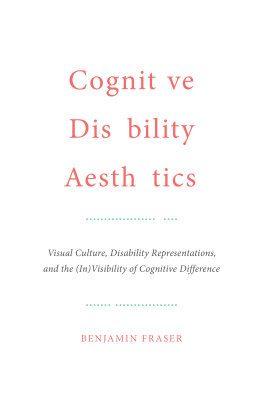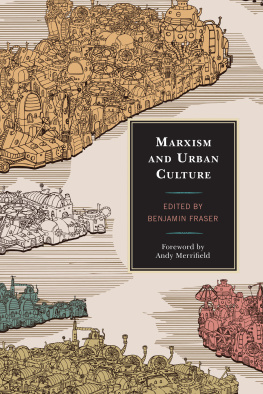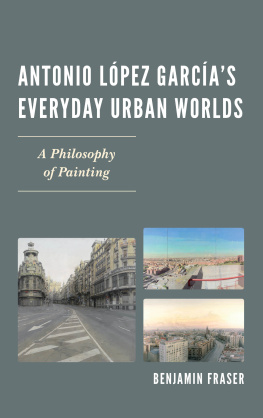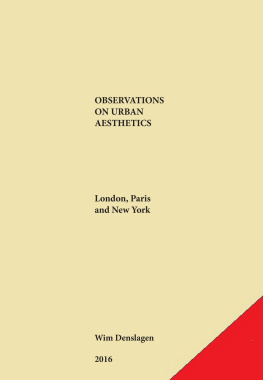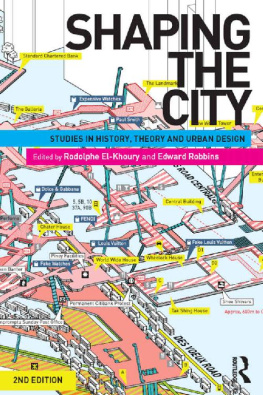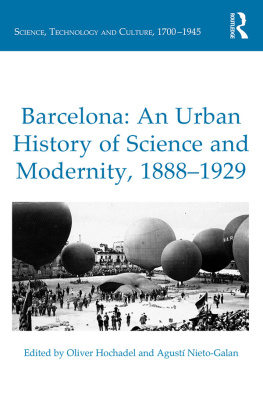Obsession, Aesthetics, and the Iberian City
Obsession, Aesthetics, and the Iberian City:
The Partial Madness of Modern Urban Culture
Benjamin Fraser
Vanderbilt University Press
Nashville, Tennessee
Copyright 2021 Vanderbilt University Press
All rights reserved
First printing 2021
LIBRARY OF CONGRESS CATALOGING-IN-PUBLICATION DATA
Names: Fraser, Benjamin, author.
Title: Obsession, aesthetics, and the Iberian city : the partial madness of modern urban culture / Benjamin Fraser.
Description: Nashville : Vanderbilt University Press, [2020] | Includes bibliographical references and index.
Identifiers: LCCN 2021033642 (print) | LCCN 2021033643 (ebook) | ISBN 9780826502377 (paperback) | ISBN 9780826502384 (hardback) | ISBN 9780826502391 (epub) | ISBN 9780826502407 (pdf)
Subjects: LCSH: City and town lifeSpain. | Cities and townsSpain. | City and town lifePortugal. | Cities and townsPortugal.
Classification: LCC HT145.S7 F47 2020 (print) | LCC HT145.S7 (ebook) | DDC 307.760946dc23
LC record available at https://lccn.loc.gov/2021033642
LC ebook record available at https://lccn.loc.gov/2021033643
CONTENTS
ACKNOWLEDGMENTS
This book draws from three previous article-length publications but adapts them to a new context. Material from the article Obsessively Writing the Modern City: The Partial Madness of Urban Planning Culture and the Case of Arturo Soria y Mata in Madrid, Spain, published by Liverpool University Press in the Journal of Literary and Cultural Disability Studies 13, no. 1 (2019): 2137, figures into the first part of , but it has been recast and expanded to deal with disability aesthetics. I thank those publishers and their journal editors for allowing the re-use and adaptation of that previous material here. I am grateful to the three anonymous reviewers and Zachary Gresham at Vanderbilt University Press for suggestions leading to a stronger volume.
Introduction.
Our Urban Obsessions
We are obsessed by the modern city. This obsession may very well be, in fact, a defining element of urban modernity. The chapters of Obsession, Aesthetics, and the Iberian City explore the need to obsessively reconstruct and represent the city by examining urban aesthetics in the cultural production of selected figures from planning, architecture, science, prose and poetry, documentary film, and the graphic novel. Yet neither are those who consume and study literature or film immune to this obsessive fascination with the urban environment. The city is a collective obsession to which all of us contribute. The fact that the book you are reading exists is further proof of the point.
Although many depictions of the city in prose, poetry, and visual art can be found dating from earlier periods in human history, Obsession, Aesthetics, and the Iberian City emphasizes a particular phase in urban development. This is the quintessentially modern city that comes into being in the nineteenth century. In social terms, this nineteenth-century city is the product of a specialist class of planners engaged in what urban theorist Henri Lefebvre has called the bourgeois science of modern urbanism. One thinks first of the large scale and the wide boulevards of Baron Georges von Haussmanns Paris or the geometrical planning vision made concrete in Ildefons Cerds Barcelona. Certainly not restricted to these specific European centers of power, the modern science of urban design famously inaugurates and disseminates a new way of thinking the city. Urban modernity comes to be defined by the triumph of exchange-value over use-value, and the lived city is eclipsed by the planned city as it is envisioned by capitalists, builders, and speculators. The present book explores this tension between planners and urbanites as it is expressed in a broadly Iberian social imaginary. Thus urban plans and architecture, literary prose and poetry, documentary cinema, and comics art all serve as windows into our modern obsession with urban aesthetics. Each of these examples are artistic texts requiring close cultural readings. By examining their structure, images, and meaning, and by seeing the modern city itself as a cultural text of sorts, the chapters that follow chart our collective cultural obsession with the urban environment from the late nineteenth century through today.
This book is neither encyclopedic nor comprehensive in terms of its scope. It does not pursue an archival history of medicine in the urban Iberian world; nor does it single out the European planning tradition for extended critique, though that is perhaps yet another worthy project.cultural obsession implicit in its reconstruction as well as the role of obsession in its artistic representation of the urban environment. These areas are Barcelonas Eixample district, Madrids Linear City, Lisbons central Baixa area, and Bilbaos Seven Streets, or Zazpikaleak. The theme of obsessionexplored below as synonymous with the concept of partial madnessprovides a point of departure for understanding the interconnection of both urbanistic and artistic discourses.
On one hand, the urbanistic thinking of such figures as Ildefons Cerd (Barcelona), Arturo Soria y Mata (Madrid), the Marqus de Pombal (Lisbon), and Pablo Alzola, Severino Achcarro, and Ernesto Hoffmeyer (Bilbao) reveals an obsessive drive in line with the hallmark tropes of a partially mad modernity outlined by disability studies scholar Lennard J. Davis in his book Obsession: A History (2008). On the other hand, an engagement with both the city and the obsessive aspects of modernity is crucial for understanding the work of architect Antoni Gaud and documentary filmmakers Mercedes lvarez and Hiroshi Teshigahara (Barcelona); prose authors Emilia Pardo Bazn and Santiago Ramn y Cajal (Madrid); poetic writers Fernando Pessoa and Cesrio Verde (Lisbon); and two collaborations by comics artists: Josep Busquet, Pedro J. Colombo, and Aintzane Landa, and also Kike Infame and Sr. Verde (Bilbao). These texts have been selected because they are markedly urban and because they manifest a quintessentially modern theme of obsessive thinking, but not because they are somehow unique. Other urban texts that indulge in obsession as a response or reaction to modernity are no doubt plentiful. The range of creative genres, urban contexts, and time periods here has been calibrated to showcase the way obsession has become a widespread cultural value of an urbanized modernity. It is not just that the creative energy motivating geometrical planning is obsessive, not just that literary authors create, and readers eagerly consume, obsessive characters, or even that modern critics have praised sprawling, obsessive works. It is that there is a certain everydayness and even banality to this obsession. Though it is seldom recognized as such, obsession is a mode of cognition valued by the modern urbanite.
This book brings together two heretofore relatively distinct bodies of knowledge, urban cultural studies, on one hand, and literary and cultural disability studies, on the other. As with my previous books, this book attends to the representation of the city in cultural production. These two bodies of knowledge overlap somewhat in the sense that both the quintessentially modern understanding of the city and the socially constructed category disability were forged during the nineteenth century. That said, this overlap is not a clean one, and the result is neither a true disability studies project nor a systematic investigation of urban cultural history.
In approaching the Iberian city, a vital disciplinary tradition of cultural studies has yielded no shortage of investigations into cultural representations, space/place, and urban modernity.Collectively, such approaches trace the cultural representations of the modern Iberian city from the nineteenth into the twentieth and twenty-first centuries. The present book draws inspiration from this rich tradition of Iberian urban critique, but also attends to important work from the interdisciplinary field of literary and cultural disability studies.


